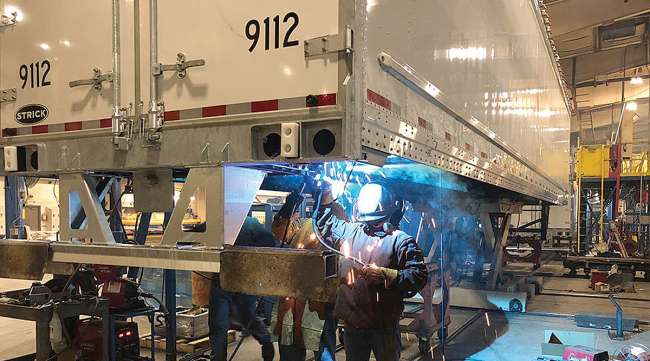Senior Reporter
October Trailer Orders Move Sharply Higher

[Stay on top of transportation news: Get TTNews in your inbox.]
Net U.S. trailer orders in October surged to 31,786 units, reaching the highest volume since November 2018 despite an overall slowing freight market, ACT Research reported.
Last October, orders were 55,399. And for the first nine months of this year they averaged 15,126, according to ACT.
“We finally got to a month where we had more orders than production, so we had a little bit of a backlog build for the first time since December,” said Frank Maly, director of commercial vehicle transportation analysis at ACT.
He said backlogs were now at 4.5 months compared with 4.2 months in September, but down from 10 months in December.

Maly
Also, he said there was still a fair amount of inventory out there.
“We still have 2,500 to 3,000 more dry vans on the ground at this point than we did a year ago,” Maly added. “Is it stuff that hasn’t been picked up yet? It’s hard to quantify and, certainly, something we would expect to be worked off as the year closes.”
FTR pegged October’s net orders at 32,100.
“It was a good month. Within that number, though, you have good things and bad things,” said Don Ake, vice president of commercial vehicles at FTR.
The bad thing, Ake said, is that gains were not consistent for all trailer makers. “They were heavily concentrated in the dry van [segment], and all the trailer makers did not have great months — only a couple.”
Also, cancellations reached 5,700, which was the highest monthly total since 2000, Ake said. But he found in that number some good news.
Record orders last year inflated the backlog, and some of the 2019 orders just got washed out, he said. “Now we are focused on 2020.”
And if cancellations had been at a normal number, net orders would have been 3,000 higher, Ake added. “They would have been 35,000, and then that’s an excellent month.”

Ake
Trailer makers subtract cancellations from preliminary orders to reach the net order volume.
One company in the market for more trailers is Convoy, a digital freight broker that in April launched its drop-and-hook program Convoy Go.
Convoy has made “many thousands” of trailers available through the program, Ziad Ismail, chief product officer at Convoy, told Transport Topics. “We are scaling out so quickly because we have seen this really, really substantial reduction in waiting and loading times at the dock.”
So far, all the Convoy trailers are leased, he added. “As we are scaling out, we are looking at how, ideally, we should combine leased trailers with owning trailers, as well.”
The trailer market is growing amid signs of a trend showing overall freight growth is slowing.
The Census Bureau reported Nov. 4 that orders for durable goods in September (the latest available data) fell as inventories rose and shipments of durable goods decreased.
At the same time, e-commerce sales in the second quarter rose 13.6% compared with the 2018 period — total retail sales increased 3.4%, according to the Census Bureau.
More recently, the Chainalytics-Cowen Freight Indices released Nov. 18 found contract and spot rates declined compared with a year earlier, with indications pointing to peak season activity that remains subdued.
Meanwhile, trailer maker executives said October’s volume is an indication ordering patterns have returned to normal.
David Giesen, vice president of sales at Stoughton Trailers, said large fleets were in the market, and “seem to be ordering normal numbers to their usual annual replacements, at least at this point.”
One concern Giesen has is the extra capacity the trailer industry has added, more than what is needed for the next couple of years, he said.
“At this point all of that capacity will not be needed so we will see some pulling back at the trailer makers,” he said.
Asked if he expected trailers will be priced lower by some trailer makers to fill added production lines, he said: “This would be a natural outcome until the capacity gets in sync with the demand.”
Maly said he is seeing aggressive pricing already.
At Great Dane, “the large fleets, including truckload, less-than-truckload, private and leasing, are in the market and placing orders,” said David Gilliland, vice president of national accounts. “We are seeing a mix of replacement and growth.”
Stuart James, chief sales officer at Hyundai Translead, said the backlog has shrunk, but not in a way that is a major concern.
“We reduced output modestly for fourth-quarter 2019, and so, despite that fact that there was a pinch in demand and a simultaneous uptick in late-year cancellations, the impact on backlog has not been severe,” James said. “The last few weeks of first-quarter 2020 might be tense, but early [in the quarter] and looking out into second quarter look sustainable at current output.”
Want more news? Listen to today's daily briefing:




